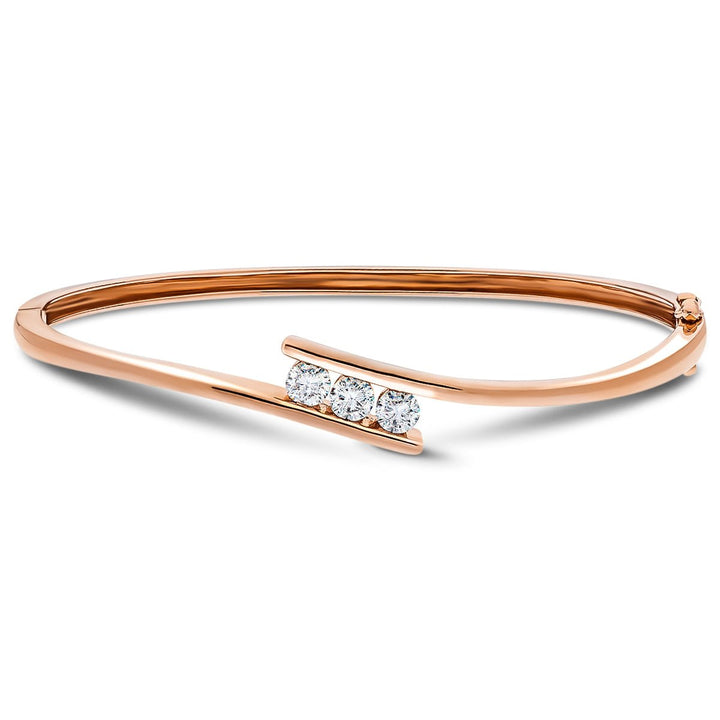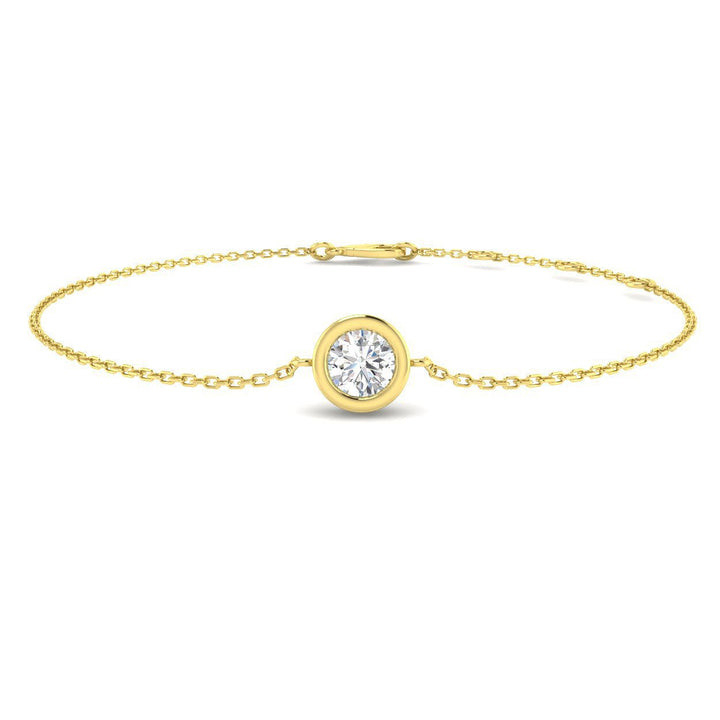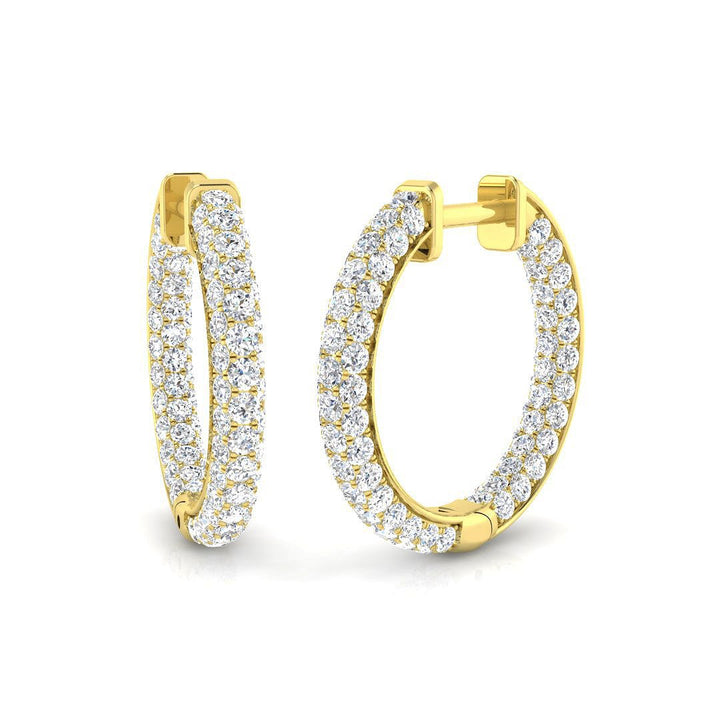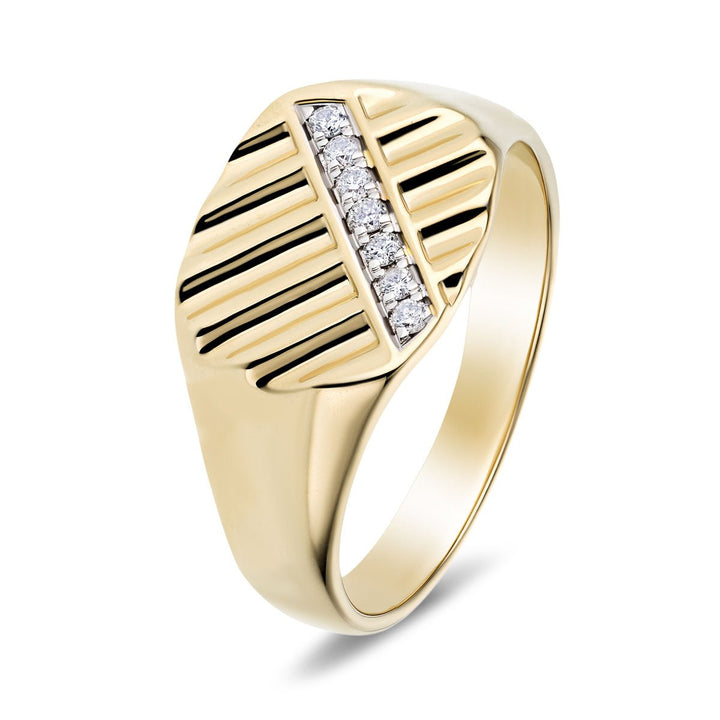In This Article
- Main Highlights
- Understanding Lab-Grown Diamonds
- Ethical Advantages of Lab-Grown Diamonds
- Quality and Consistency Benefits
- Environmental Impact Comparison
- Cost and Value Analysis
- Consumer Perception Trends
- Embracing Ethical Elegance: The Future of Lab-Grown Diamonds
- Discover Your Perfect Ethical Diamond Today
- Frequently Asked Questions
- How Do Lab-Grown Diamonds Compare to Synthetic Gemstones?
- What Is the Typical Production Time for Lab-Grown Diamonds?
- Can Lab-Grown Diamonds Be Used in Industrial Applications?
- Are There Any Cultural Considerations With Gifting Lab-Grown Diamonds?
- How Are Lab-Grown Diamonds Insured Compared to Mined Diamonds?
Lab-grown diamonds represent a remarkable conflict-free alternative to traditional mined diamonds, offering considerable ethical and environmental benefits. Produced in controlled settings, these diamonds circumvent the human rights violations and environmental damage often associated with mining. Their production methods, including High Pressure High Temperature (HPHT) and Chemical Vapour Deposition (CVD), result in notably reduced carbon emissions and water usage, conserving natural habitats. Furthermore, lab-grown diamonds support fair labour practices and exhibit high-quality standards, assured by rigorous certification processes. Financially accessible, they cost 60%-85% less than natural diamonds, appealing especially to ethically-conscious consumers seeking gemstone brilliance without ethical compromise. Uncover more about their remarkable advantages.
Main Highlights
- Lab-grown diamonds are produced in conditions that prevent human rights abuses and environmental harm.
- Transparent sourcing and traceability of lab-grown diamonds support ethical consumer choices.
- Sustainable practices in lab-grown diamond production preserve natural habitats and reduce resource strain.
- Fair labour practices and equitable wages are ensured in the lab-grown diamond industry.
- Lab-grown diamonds have a significantly lower ecological footprint compared to mined diamonds.
Molly Three Stone Lab Diamond Engagement Ring 1.50ct G/VS in 9k Yellow Gold

£910.00
£1,736.00
The Molly Three Stone Lab Diamond Engagement Ring is the perfect choice for your love story, crafted by hand in the UK with the finest materials. This stunning ring boasts 1.50 carats of G/VS IGI-certified lab-grown diamonds, set in warm… read more
Understanding Lab-Grown Diamonds
Lab-grown diamonds, a remarkable innovation in gemology, are real diamonds cultivated in controlled laboratory settings that replicate the Earth's natural high-pressure and high-temperature conditions. These diamonds are created using two primary methods: High Pressure High Temperature (HPHT) and Chemical Vapour Deposition (CVD).
While natural diamonds take millions of years to form, lab-grown diamonds develop in approximately 6 to 10 weeks for large stones and much less time for typical gems, offering a viable alternative with identical physical, chemical, and optical properties. Notably, lab-grown diamonds can reach up to 20 carats in size, though they are generally smaller than the largest natural diamonds.
Lab-grown diamonds reduce carbon emissions by up to 60% compared to mined diamonds, making them a more environmentally friendly option. The production of lab-grown diamonds also significantly reduces water usage, promoting sustainability in comparison to traditional diamond mining. Identification methods are essential for distinguishing lab-grown diamonds from their natural counterparts. Specialist equipment, such as spectroscopy and DiamondView testers, reveal unique "fingerprints" like fluorescence patterns and inclusions specific to lab-grown diamonds.
The Gemological Institute of America (GIA) plays an important role in diamond certifications, providing detailed reports on colour, clarity, and cut. Each lab-grown diamond is laser-inscribed with a report number and a statement identifying it as laboratory-grown, ensuring authenticity and transparency. These certifications not only validate the quality of lab-grown diamonds but also foster trust within the community of diamond enthusiasts.
The GIA employs gemological and spectroscopic techniques to analyse and certify diamonds, ensuring accurate identification. By understanding the identification methods and certification processes, individuals can appreciate the cutting-edge science and artistry behind lab-grown diamonds.
Lab Diamond 11 Stone Half Eternity Ring 0.40ct D/VVS in 9k White Gold

£375.00
£655.00
The Lab Diamond 11 Stone Half Eternity Ring is elegant and delicate, featuring 0.40ct of D/VVS quality diamonds shining with unparalleled brilliance. Set in 9k white gold, this ring boasts a 2.4mm band with 40% diamond coverage, offering a sophisticated… read more
Ethical Advantages of Lab-Grown Diamonds
Building upon the understanding of lab-grown diamonds, their ethical advantages present a compelling case for consumers committed to socially responsible purchasing.
Lab-grown diamonds are crafted in controlled environments, sidestepping the human rights abuses and environmental degradation often linked to traditional mining. This production method not only guarantees transparency and traceability benefits, allowing consumers to trace the diamond's origin with confidence, but also aligns with the values of social justice.
The innovative technology used in their creation supports environmentally-conscious consumer choices. Furthermore, lab-grown diamonds are typically more cost-effective due to their abundance and lower production costs. Additionally, the increasing consumer awareness of ethical sourcing and eco-friendly products is driving a shift towards sustainable jewellery, particularly lab-grown diamonds.
By eliminating forced and exploitative labour practices, lab-grown diamonds promote a fair and humane work environment, characterised by regulated conditions, advanced safety protocols, and equitable wages. This shift signifies an essential move towards a more conscientious diamond industry, where the ecological footprint is considerably reduced. The adoption of renewable energy by some lab-grown diamond producers further enhances their sustainability credentials.
Unlike their mined counterparts, lab-grown diamonds require less energy and water, further improved by the potential use of renewable energy sources.
The humanitarian advantages are profound; lab-grown diamonds are unassociated with child labour or community exploitation, providing consumers with a guilt-free luxury option.
In choosing lab-grown diamonds, individuals contribute to a responsible and compassionate approach, fostering a sense of belonging within a community that prioritises ethical and sustainable choices in luxury jewellery.
Lab Diamond Three Stone Bangle 0.75ct in D/VVS 18k Rose Gold

£2,430.00
£5,395.00
Discover the epitome of elegance with the Lab Diamond Three Stone Bangle, a masterpiece that combines striking design with modern style. This exquisite piece features 0.75ct of real diamonds in a tension setting, creating a dazzling display of brilliance and… read more
Quality and Consistency Benefits
The strict grading standards set by institutions like IGI and GIA further bolster their credibility, as these diamonds are subjected to rigorous evaluation processes.
Lab-grown diamonds reflect a growing trend in the jewellery market, with sales increased from less than $1 billion in 2016 to nearly $12 billion in 2022, showcasing their rising acceptance and popularity. Recent studies highlight the lower environmental impact of lab-grown diamonds compared to their mined counterparts, further underscoring their appeal to ethically conscious consumers. Market analysts predict a significant growth in the demand for synthetic diamonds, as innovations continue to enhance quality and expand into new markets globally.
Markdown list of quality and consistency benefits:
1. Controlled Production: Lab-grown diamonds are created in environments where colour, clarity, and inclusions can be meticulously regulated.
2. Consistent Characteristics: Lab diamonds exhibit fewer variations, providing consumers with products of predictable quality.
3. Grading and Certification: They are graded and certified by **reputable bodies**, ensuring adherence to stringent quality standards.
4. Detailed Reports: Each diamond comes with a thorough report detailing its origin and characteristics, fostering transparency and trust.
In essence, lab-grown diamonds not only match but often exceed the quality of natural diamonds in hardness and brilliance, offering lasting value and durability.
Lab Solitaire Diamond Bracelet 0.50ct G/VS Quality in 18k Yellow Gold

£600.00
£1,151.00
The Lab Solitaire Diamond Bracelet offers a refined touch of luxury with its subtle modern style, featuring a 0.50ct genuine solitaire diamond. This exquisite diamond, measuring 5.0mm, is bezel set into the lustrous 18k yellow gold, showcasing the stone's beauty… read more
Environmental Impact Comparison
The environmental impact of diamond production presents a stark contrast between mined and lab-grown variants, with the latter demonstrating considerable ecological advantages.
Mined diamonds considerably strain natural resources, requiring 3,900 litres of water and producing 6,000 pounds of mineral waste per carat. In stark contrast, lab-grown diamonds utilise sustainability practices by considerably reducing resource consumption, with processes often integrating recycled water and minimising waste. Consumer preferences highlight the importance of this shift, with a significant portion of buyers prioritising eco-friendly purchases, especially in emerging markets where up to 88% of consumers favour sustainable products.
Energy-wise, mined diamonds consume 101 kilowatt-hours per carat, contributing 108.5 kilograms of CO2 emissions, whereas the lab-grown process uses less than half the energy, with a mere 0.028 grams of CO2 emitted per carat. The total carbon footprint of diamonds mined annually is equivalent to millions of cars, highlighting the significant environmental burden of traditional diamond mining.
Lab-grown diamonds also create minimal land disturbance, as production occurs in controlled laboratory environments, thereby preserving natural habitats and biodiversity. This approach considerably diminishes ecological damage compared to the nearly 100 square feet of land disruption caused by mining each carat of diamond.
While variations in lab-grown production methods can affect sustainability, the potential for renewable energy use further underscores their environmental promise.
Fundamentally, lab-grown diamonds align with modern sustainability practices, offering an environmentally conscious alternative that resonates with those committed to reducing their ecological footprint.
Lab Diamond Heart Pendant Necklace 0.50ct in 925 Silver

£380.00
£745.00
This exquisite Lab Diamond Heart Pendant Necklace features a total diamond weight of 0.50ct, encapsulating luxury and precision. Each lab-created diamond is meticulously chosen for its superior quality, boasting a D/VVS grade that reflects exceptional clarity and brilliance. The heart-shaped… read more
Cost and Value Analysis
Lab-grown diamonds offer a compelling cost advantage over their natural counterparts, primarily due to efficient production processes that considerably lower prices. These diamonds are available at 60% to 85% less than the cost of natural diamonds, largely due to advanced manufacturing methods like HPHT and CVD. However, the pricing strategies employed in this market come with inherent resale challenges. Lab-grown diamonds typically retain less than 30% of their original price, a stark contrast to the 50% retention often seen with natural diamonds - of course, this difference is countered by the much lower cost of lab diamonds when purchased new.
Factors influencing the cost and value analysis include:
1. Price Trends: Lab-grown diamond prices have declined considerably, with a 35% drop over recent years, partially driven by increased competition and technological advancements. The market has seen a surge in the popularity of lab-grown diamonds among budget-conscious buyers, contributing to the increased competition.
2. Quality Control: Improved quality control in production reduces imperfections and contributes to lower pricing, making lab diamonds an accessible luxury.
3. Certification Impact: Certifications like IGI and GIA improve credibility, affecting consumer trust and pricing strategies. The Rapaport Pricing Method is commonly used to price lab-grown diamonds based on the 4Cs, ensuring a standardised approach to valuation.
These dynamics illustrate the need for strategic pricing approaches and awareness of resale limitations in the lab-grown diamond market.
Chloe Lab Diamond Halo Oval Engagement Ring 0.85ct G/VS in 18k Yellow Gold

£995.00
£1,901.00
Capture the essence of love with the enchanting Chloe Lab Diamond Halo Oval Engagement Ring, crafted by hand in 18k yellow gold. This ring boasts a 0.85-carat total weight of G/VS-graded diamonds, with an oval cut diamond at the centre… read more
Consumer Perception Trends
Amid the evolving jewellery landscape, consumer perception of lab-grown diamonds is shifting considerably. With increased awareness, 80% of consumers now recognise lab-grown diamonds, marking a notable rise from previous years. This awareness is essential as consumers gravitate towards sustainable and ethical choices, aligning with their preferences. However, 47% still need education to perceive lab-grown diamonds as "real."
Younger consumers, in particular, view them as a legitimate alternative, driven by their ethical appeal and affordability. As consumers become more discerning, concerns about the rarity and value retention of lab-grown diamonds continue to influence purchasing decisions. The environmental and ethical appeal of lab-grown diamonds is a significant factor driving their increasing popularity among younger generations.
Despite certain market perceptions favouring natural diamonds, the lab-grown diamond market is positioned for significant growth. Projected to reach £49.9 billion by 2030, it is expanding at a compound annual growth rate of 9.4%. This growth is fuelled by younger generations, who prioritise ethical and environmentally friendly products.
While natural diamonds retain a strong emotional connection for many, lab-grown diamonds are gaining traction due to their value and sustainability. As consumer preferences evolve, transparency in production and continued education will be significant in reshaping perceptions.
Pave Set Lab Diamond Hoop Earrings 2.00ct D/VVS in 9k Yellow Gold

£1,075.00
£2,195.00
Elevate your elegance with these Pave Set Lab Diamond Hoop Earrings, featuring a total of 2.00ct D/VVS quality diamonds. Each round lab-grown diamond is meticulously set in a pave arrangement, showcasing brilliance and sophistication. These earrings are crafted in 9k… read more
Embracing Ethical Elegance: The Future of Lab-Grown Diamonds
Lab-grown diamonds deliver dazzling ethical advantages, offering a conflict-free alternative to mined gems. Their superior quality and consistency, coupled with minimal environmental impact, underscore a sustainable shift in the jewellery industry. Cost efficiency and value appeal to an increasing number of conscientious consumers, who are swayed by the sparkling synthesis of science and sustainability. This consumer trend reflects a growing preference for products that prioritise ethical origins, underscoring the transformative potential of technology in redefining luxury.
Mens Lab Diamond Signet Ring 0.10ct D/VVS in 9k Yellow Gold

£450.00
£995.00
Introducing the epitome of masculine elegance: the Men's Lab Diamond Signet Ring, featuring 0.10ct of real diamonds that capture the essence of sophistication. Set in 9k yellow gold, this ring displays a row of diamonds, meticulously held in a classic… read more
Discover Your Perfect Ethical Diamond Today
Ready to make a meaningful choice without compromising on beauty or brilliance? Explore our exquisite collection of lab-grown diamonds and ethical jewelry. Each piece combines stunning craftsmanship with the assurance of conflict-free and environmentally conscious origins.
Join the growing movement towards sustainable luxury. Visit our collection page or contact our experts to find the perfect diamond for your special moments.
Frequently Asked Questions
How Do Lab-Grown Diamonds Compare to Synthetic Gemstones?
Lab-grown diamonds and synthetic gemstones share identical properties with their natural counterparts. The key distinction lies in ethical implications; lab-grown diamonds are conflict-free, offering a sustainable alternative to natural gems, appealing to ethically-conscious consumers seeking belonging.
What Is the Typical Production Time for Lab-Grown Diamonds?
Lab-grown diamonds can be produced within 2-19 days, depending on size and production methods. Utilising advanced growth techniques like HPHT and CVD, these diamonds offer a sustainable, efficient alternative, appealing to environmentally-conscious consumers seeking ethically sourced gemstones.
Can Lab-Grown Diamonds Be Used in Industrial Applications?
Lab-grown diamonds are increasingly integral to industrial uses, benefiting from technological advancements. Their exceptional hardness, thermal conductivity, and purity improve applications in cutting tools, electronics, and scientific research, fostering a sense of belonging in creative industrial communities.
Are There Any Cultural Considerations With Gifting Lab-Grown Diamonds?
Cultural perceptions influence gifting traditions, reminiscent of how society's tales shape values. Lab-grown diamonds, while modern and sustainable, might lack the historical allure, yet offer an opportunity for new narratives, blending innovation with sentimental significance in gifting. This aspect of lab diamonds varies widely across the globe, being much more acceptable in western countries and less so in Asia.
How Are Lab-Grown Diamonds Insured Compared to Mined Diamonds?
Lab-grown diamonds are insured through specialised jewellery insurance policies that reflect their valuation differences compared to mined diamonds. These differences often result in lower premiums, with policies covering the full appraised value while considering current market value.
Start Your Journey Towards Ethical Elegance Now!








